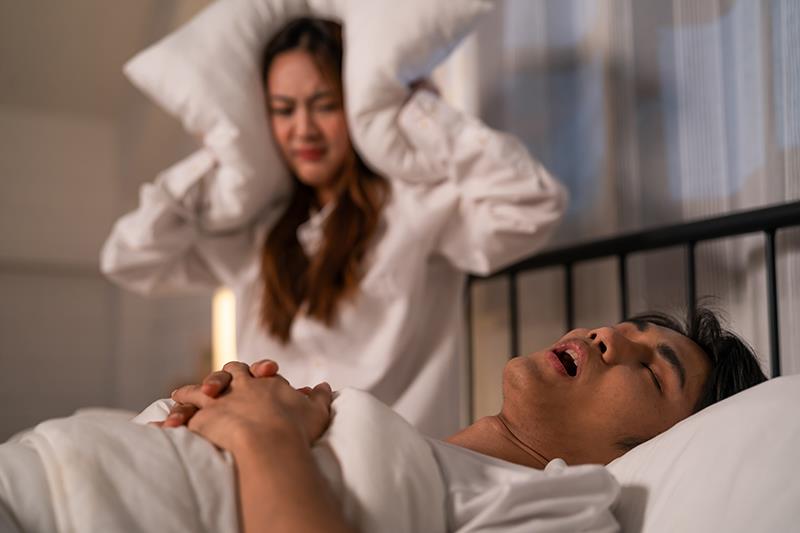Anticonvulsant shows promise for OSA treatment





In a dose-ranging study presented at ERS 2024, the carbonic anhydrase inhibitor sulthiame (STM), an anticonvulsant, reduced sleep-disordered breathing and improved sleep quality, hypoxia, and daytime sleepiness in individuals with obstructive sleep apnoea (OSA).
“The standard treatment for OSA is sleeping with a machine that blows air through a face mask to keep the airways open. Unfortunately, many people find these machines hard to use over the long term, so there is a need to find alternative treatments,” said Professor Jan Hedner from Gothenburg University in Sweden. “We also need a better understanding of the underlying mechanisms in OSA to help clinicians give a more personalized treatment.”
“[I]n the trial, [individuals on STM] had a reduction in OSA symptoms such as stopping breathing during the night and feeling sleepy during the day,” he said, adding that STM also improved their average blood oxygen levels. These suggest that STM may be effective for treating OSA, especially for those who cannot use existing mechanical treatment alternatives.
The study included 298 individuals with OSA (mean age 56 years, 73.8 percent men, mean BMI 29 kg/m2) who cannot accept or tolerate CPAP* or oral splints. They were randomized 1:1:1:1 to STM 100, 200, 300 mg, or placebo and evaluated by polysomnography. [ERS 2024, abstract OA5433]
The primary efficacy endpoint – relative change in AHI3a** from baseline to week 15 – was met with STM 100, 200, and 300 mg (–17.8 percent; p<0.05, –34.8 percent; p<0.0001, and –39.9 percent; p<0.0001, respectively).
In the post hoc analysis, STM 300 mg slashed AHI4** by nearly 50 percent (p<0.001). For the 100- and 200-mg doses, the corresponding reductions were 26.2 percent (p<0.013) and 36.8 percent (p<0.001).
Mean O2 saturation improved by 0.95 percent and 0.87 percent with STM 200 and 300 mg, respectively (p<0.0001 for both). Both doses also reduced ODI*** 3 percent (5.5 percent; p=0.008 and 6.5 percent; p<0.0001). These measures indicate improved oxygenation with STM.
In terms of total arousal index, the changes from baseline to week 15 were greater with all STM doses vs placebo (–3.1; p=0.04, –5.7; p<0.001, and –6.7; p<0.0001 for 100, 200, and 300 mg, respectively). The greater reductions denote significant improvements in sleep fragmentation and quality, with no clinically relevant reduction of REM sleep, noted Hedner. “There was also an increase in total sleep time and sleep inefficiency.”
Sleepiness also improved with STM vs placebo, as reflected by the mean reductions in ESS# from baseline to week 15 (1.8, 1.8, and 1.3 [100, 200, and 300 mg] vs 0.9 [placebo]). A similar pattern was seen in the subgroup of ‘sleepy’ patients (ESS ≥11; 3.2, 3.5, and 2.7 vs 1.1), suggesting that STM decreased excessive daytime sleepiness.
There was also the expected blood pressure (BP)-lowering effect with STM – particularly with the 200- and 300 mg-doses – vs placebo. This effect was seen for both systolic and diastolic BP.
Adverse events (AEs) were generally mild to moderate and dose-dependent without cardiovascular safety issues. Treatment-emergent AEs (TEAE) align with the known safety profile of STM. The frequency was dose-dependent and expected, including paraesthesia, headache, dyspnoea, and nausea, Hedner noted. The paraesthesia was intermittent, mild, and mainly restricted to the fingertips.
“[Taken together, these results suggest that] STM is a promising novel candidate for pharmacological treatment in OSA,” said Hedner. “Although STM is already available as a treatment for childhood epilepsy, we still need to carry out a phase III study to confirm the beneficial respiratory effects of this drug in a larger group of OSA patients.”
Available Tx not for everyone
In the ERS press release, Professor Sophia Schiza from the University of Crete in Greece, who was not involved in the study, underlined the importance of seeking consult should snoring be accompanied by other symptoms such as frequent waking at night or feeling fatigued and/or sleepy during the daytime.
“Because OSA increases the risk of serious health problems … it is vital that we diagnose and treat the condition. Treatments are available, but because they do not work for everyone, we need more ways to treat the disease based on individualized diagnostic and treatment approaches,” Schiza continued.
“This is one of the first studies to suggest that a drug treatment could help some patients, and the results are promising. We need to continue testing STM and other treatments to understand their long-term effects, including any side effects,” Schiza added.